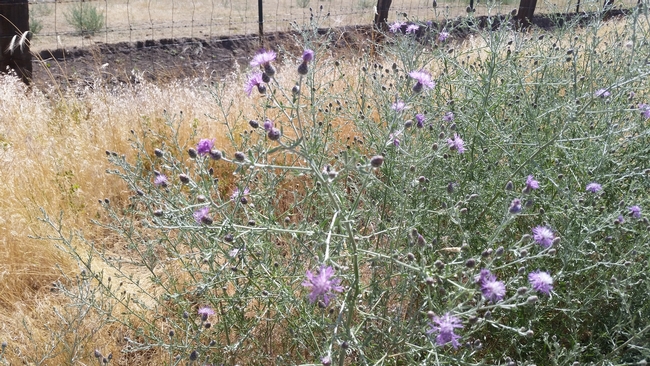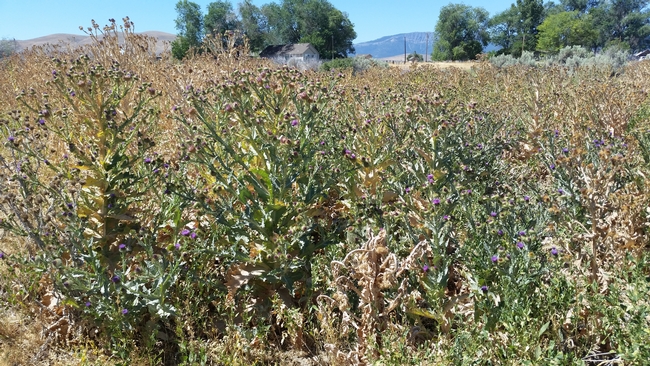Recently I was a participant on an educational noxious weed tour in Sierra Valley. It is a beautiful mountain valley where most agricultural production is devoted to grazing and hay production. The tour was set up by the Plumas Weeds group, to show land managers and ranchers various noxious weeds which are invading Sierra Valley. We discussed identification, biology, and control options for a variety of weed species. One of the questions which was inevitably brought up for each species was: “How long is the soil seed life of this weed?” This question led to interesting conversations.
When we stopped to look at hoary cress (Lepidium Draba) we had a relatively optimistic conversation. Hoary cress is a B list noxious weed in California, and according to the literature has a soil seed life fewer than three years. With a three-year soil seed life success seems obtainable, and people in the group seemed optimistic that with some work this was a weed that they could get a handle on.
Another plant which has isolated populations in Sierra valley is spotted knapweed (Centaurea stobe L. spp. micranthos) an A rated noxious weed in the state. It has beautiful purple flowers but unfortunately can create dense monocultures excluding desirable vegetation. In the literature, soil seed life is listed as 8 years for spotted knapweed more than double that of hoary cress. Tim Gibson the Agricultural Commissioner of Plumas and Sierra counties spoke about his experiences of treating infestations of spotted knapweed for many years before successful eradication was achieved. On a tour Tim gave me last summer, I remember him slamming on the breaks of the county SUV to pull a single spotted knapweed plant he had seen out the window. That is the type of dedication we all need to have with noxious weed management, get them when you see them!
Stopping to look at scotch thistle (Onopordum acanthium), the conversation about control became more daunting, as the literature states a soil seed life of 30 years. Scotch thistle is an A list noxious weed species in California, with very limited distribution in the Sierra Valley and most of the tour participants did not have any experience with it. As you move north in the state from the Sierra Valley it is considered one of the worst weeds in Lassen and Modoc counties. The Modoc County Agricultural Commissioner Joe Moreo has described just how difficult dealing with the plant can be. Certain Scotch thistle sites have been treated annually since he started with the Modoc Agricultural Commissioners Department over 15 years ago. Yet, year after year more scotch thistle plants continue to germinate at these sites (although fewer and fewer). People did not seem to be nearly as enthused with the potential success of controlling scotch thistle, especially after I shared the experiences Joe has had with the plant.
Managing a species with a 30-year soil seed life is a formidable task, and thankfully not all weeds produce seeds that last so long. But the question is: How do you manage the ones that have such a long soil seed life, and what sort of mindset do you need?
Prevention of seed formation has to be step number one, step two and maybe even step number three. The recent Article in California Ag Today “Vigilant Seed Bank Reduction: Whatever it takes don't let weeds set seed” (which was re-posted on this blog a few weeks ago), does a great job of emphasizing this. Prevention of any reproductive plant tissue is always the most important step.
In terms of the mindset needed, I think that looking at things like a forester might do the trick. I have always been in awe of people planting and caring for trees which will be harvested by their children's generation, or even their grandchildren's generation. The idea of taking actions today, which will provide long-term benefit needs to be a foundation of weed management practices. Especially when dealing with species that have seeds which can lay dormant for decades.
The Plumas Weeds group is a good bunch of individuals and organizations devoted to weed management, and it was great that the soil seed bank was a topic of conversation on the tour.
Here is a link to an informative article written about soil seed bank management.
(Written by Fabian Menalled, and Mark Schonbeck, in 2013 posted on extension.org.)

